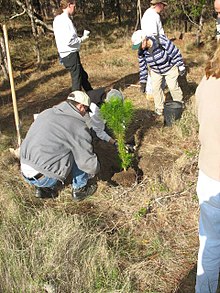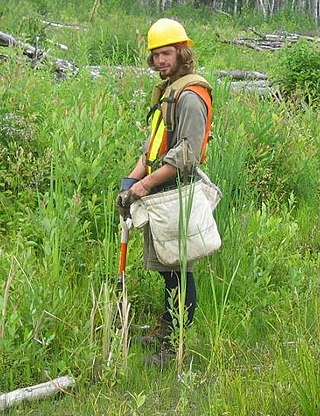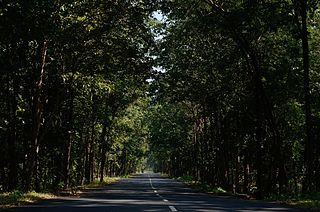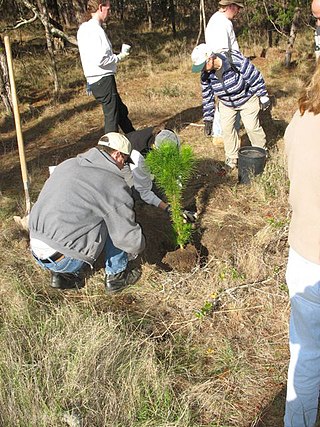
Urban reforestation is the practice of planting trees, typically on a large scale, in urban environments. [1] It may also include urban horticulture and urban farming. [2]

Urban reforestation is the practice of planting trees, typically on a large scale, in urban environments. [1] It may also include urban horticulture and urban farming. [2]
Reasons for practicing urban reforestation include urban beautification; increasing shade; [1] modifying the urban climate; [3] improving air quality, [4] such as by sequestering carbon dioxide; [5] and restoration of urban forests after a natural disaster. [6] Increased shade from urban reforestation can also lead to decreased energy costs, as heat from the sun is blocked from heating structures that use air conditioning. [5] These benefits may aid in increasing local property values, filtering rainwater pollutants from the streets and thus improving water quality, [7] and creating more habitats for wildlife, [7] particularly endangered species. [5]
Urban reforestation may also be effective because it does not require the purchase of a large piece of land to execute. [8]
The Urban Reforestation organization in Australia is a grassroots organization that focuses on sustainable living in urban places. [2]
Large scale urban reforestation programs in the United States include New York City's Million Tree Initiative [9] and TreePeople in Los Angeles, which planted 1 million trees in preparation for the 1984 Summer Olympics and continued planting thereafter. [1] In 2022, Boston announced a new forestry division to grow the tree canopy within the city. [10]
Grassroots efforts include Friends of the Urban Forest in San Francisco, which advocates for the planting of street trees. [1]
In California, there are government funded programs such as the California Department of Forestry and Fire Protection's Urban Forestry Program. They advocate for local sustainability as well as health and happiness for the community long term. [11] This Urban Forestry Program also seeks to aid disadvantaged and/or low-income communities. [12]
Most cities have the potential to use urban reforestation as a means of combating climate change. [13] Urban reforestation can also contribute to lowering energy consumption. [13]

Urban reforestation efforts compete for money and urban land that could be used for other purposes. For example, effort placed in planting new trees can take away from maintenance of already established trees. [9] Equity of where urban reforestation occurs may also be questioned. Programs such as California Department of Forestry and Fire Protection's Urban Forestry target these communities, but this is not always the case. Inequality in distribution of trees planted during Urban Reforestation leads to inequality of life. Permanence of trees is also an issue as a tree planted is a tree that might have to be removed in the future due to preferences of land owners in urban spaces. [5]
Urban reforestation projects may also lack support in neighborhoods where environmentalist groups do not sufficiently involve residents in planning and decision-making, particularly when white environmentalists are conducting projects in communities of color, as noted in a 2014 report by environmental sociologist Dorceta Taylor from the University of Michigan. For example, from 2011 to 2014, a nonprofit organization named The Greening of Detroit planted thousands of new trees to restore Detroit's tree canopy. However, about a quarter of residents offered free trees in front of their homes submitted a "no tree request". Although they recognized the benefits of urban forestry, they didn't trust the organization staff, who were predominantly white and not from Detroit. They also felt that they didn't have enough say in what was being planted since they expected to be given responsibility for maintaining the trees planted in their neighborhoods, as previous reforestation project trees received inadequate care from the city and caused issues with appearance and safety. [14] Residents were a lot more open to the idea of receiving free trees if they got to choose what was planted. [15]

A forest is an ecosystem characterized by a dense community of trees. Hundreds of definitions of forest are used throughout the world, incorporating factors such as tree density, tree height, land use, legal standing, and ecological function. The United Nations' Food and Agriculture Organization (FAO) defines a forest as, "Land spanning more than 0.5 hectares with trees higher than 5 meters and a canopy cover of more than 10 percent, or trees able to reach these thresholds in situ. It does not include land that is predominantly under agricultural or urban use." Using this definition, Global Forest Resources Assessment 2020 found that forests covered 4.06 billion hectares, or approximately 31 percent of the world's land area in 2020.

The Arbor Day Foundation is an American 501(c)(3) nonprofit membership organization dedicated to planting trees. The Arbor Day Foundation has more than one million members and has planted more than 500 million trees in neighborhoods, communities, cities and forests throughout the world. The Foundation's stated mission is "to inspire people to plant, nurture, and celebrate trees."

Reforestation is the practice of restoring previously existing forests and woodlands that have been destroyed or damaged. The prior forest destruction might have happened through deforestation, clearcutting or wildfires. Two important purposes of reforestation programs are for harvesting of wood or for climate change mitigation purposes. Reforestation can also help with ecosystem restoration. One method for reforestation is to establish tree plantations, also called plantation forests. They cover about 131 million ha worldwide, which is 3 percent of the global forest area and 45 percent of the total area of planted forests.

Logging is the process of cutting, processing, and moving trees to a location for transport. It may include skidding, on-site processing, and loading of trees or logs onto trucks or skeleton cars. In forestry, the term logging is sometimes used narrowly to describe the logistics of moving wood from the stump to somewhere outside the forest, usually a sawmill or a lumber yard. In common usage, however, the term may cover a range of forestry or silviculture activities.

Tree planting is the process of transplanting tree seedlings, generally for forestry, land reclamation, or landscaping purposes. It differs from the transplantation of larger trees in arboriculture and from the lower-cost but slower and less reliable distribution of tree seeds. Trees contribute to their environment over long periods of time by providing oxygen, improving air quality, climate amelioration, conserving water, preserving soil, and supporting wildlife. During the process of photosynthesis, trees take in carbon dioxide and produce the oxygen we breathe.

Urban forestry is the care and management of single trees and tree populations in urban settings for the purpose of improving the urban environment. Urban forestry involves both planning and management, including the programming of care and maintenance operations of the urban forest. Urban forestry advocates the role of trees as a critical part of the urban infrastructure. Urban foresters plant and maintain trees, support appropriate tree and forest preservation, conduct research and promote the many benefits trees provide. Urban forestry is practiced by municipal and commercial arborists, municipal and utility foresters, environmental policymakers, city planners, consultants, educators, researchers and community activists.

Forestation is a vital ecological process where forests are established and grown through afforestation and reforestation efforts. Afforestation involves planting trees on previously non-forested lands, while reforestation focuses on replanting trees in areas that were once deforested. This process plays an important role in restoring degraded forests, enhancing ecosystems, promoting carbon sequestration, and biodiversity conservation.

Afforestation is the establishment of a forest or stand of trees (forestation) in an area where there was no recent tree cover. In comparison, reforestation means re-establishing forest that have either been cut down or lost due to natural causes, such as fire, storm, etc. There are three types of afforestation: Natural regeneration, agroforestry and tree plantations. Afforestation has many benefits. In the context of climate change, afforestation can be helpful for climate change mitigation through the route of carbon sequestration. Afforestation can also improve the local climate through increased rainfall and by being a barrier against high winds. The additional trees can also prevent or reduce topsoil erosion, floods and landslides. Finally, additional trees can be a habitat for wildlife, and provide employment and wood products.

An urban forest is a forest, or a collection of trees, that grow within a city, town or a suburb. In a wider sense, it may include any kind of woody plant vegetation growing in and around human settlements. As opposed to a forest park, whose ecosystems are also inherited from wilderness leftovers, urban forests often lack amenities like public bathrooms, paved paths, or sometimes clear borders which are distinct features of parks. Care and management of urban forests is called urban forestry. Urban forests can be privately and publicly owned. Some municipal forests may be located outside of the town or city to which they belong.
American Forests is a 501(c)(3) non-profit conservation organization, established in 1875, and dedicated to protecting and restoring healthy forest ecosystems. The current headquarters are in Washington, D.C.

TreePeople is an educational and training environmental advocacy organization based in Los Angeles, California. The TreePeople organization advocates and works to support sustainable urban ecosystems in the Greater Los Angeles area through education, volunteer community-based action, and advocacy.

Social forestry is the management and protection of forests and afforestation of barren and deforested lands with the purpose of helping environmental, social and rural development. The term social forestry was first used in 1976 by The National Commission on Agriculture, when the government of India aimed to reduce pressure on forests by planting trees on all unused and fallow lands. It was intended as a democratic approach to forest conservation and usage, maximizing land utilization for multiple purposes.

The Monterey County reforestation refers to efforts in Monterey County, California, to preserve the county's pine forests and urban environment. This one county boasts the native Monterey Pine ecosystem; one of the rarest forest ecosystems in the world. Only a few thousand acres of these endemic trees exist in four locations along the Pacific Ocean on the Central Coast of California. The city of Monterey itself maintains more than 19,000 trees in parks and along streets, as well as about 300 acres (1.2 km2) of Monterey Pine forests.

Tampa Bay Reforestation and Environmental Effort, Inc. more commonly known as "T.R.E.E. Inc.", was a grassroots nonprofit environmental organization based out of the Tampa Bay Area. It promoted the practice of volunteers raising and then planting trees along the interstates, roadways, and parks of the greater Tampa Bay Area to beautify and preserve the environment. Over its 40-year existence, T.R.E.E. Inc. planted over 31,181 trees and palms.

Forest restoration is defined as “actions to re-instate ecological processes, which accelerate recovery of forest structure, ecological functioning and biodiversity levels towards those typical of climax forest” i.e. the end-stage of natural forest succession. Climax forests are relatively stable ecosystems that have developed the maximum biomass, structural complexity and species diversity that are possible within the limits imposed by climate and soil and without continued disturbance from humans. Climax forest is therefore the target ecosystem, which defines the ultimate aim of forest restoration. Since climate is a major factor that determines climax forest composition, global climate change may result in changing restoration aims. Additionally, the potential impacts of climate change on restoration goals must be taken into account, as changes in temperature and precipitation patterns may alter the composition and distribution of climax forests.

Forest conservation is the practice of planning and maintaining forested areas for the benefit and sustainability of future generations. Forest conservation involves the upkeep of the natural resources within a forest that are beneficial for both humans and the ecosystem. Forests provide wildlife with a suitable habitat for living which allows the ecosystem to be biodiverse and benefit other natural processes. Forests also filter groundwater and prevent runoff keeping water safe for human consumption. There are many types of forests to consider and various techniques to preserve them. Of the types of forests in the United States, they each face specific threats. But, there are various techniques to implement that will protect and preserve them.

The Greening of Detroit is a 501(c)(3) non-profit environmental organization whose mission is to inspire the sustainable growth of a healthy urban community through trees, green spaces, healthy living, education, training and job opportunities. The Greening serves communities in Detroit, Highland Park and Hamtramck, Michigan.

Deforestation is a primary contributor to climate change, and climate change affects the health of forests. Land use change, especially in the form of deforestation, is the second largest source of carbon dioxide emissions from human activities, after the burning of fossil fuels. Greenhouse gases are emitted from deforestation during the burning of forest biomass and decomposition of remaining plant material and soil carbon. Global models and national greenhouse gas inventories give similar results for deforestation emissions. As of 2019, deforestation is responsible for about 11% of global greenhouse gas emissions. Carbon emissions from tropical deforestation are accelerating.

Assisted migration is the movement of populations or species by humans from one territory to another in response to climate change. This is the definition offered in a nontechnical document published by the United States Forest Service in 2023, suggesting that this form of climate adaptation "could be a proactive, pragmatic tool for building climate resilience in our landscapes."
Urban forest inequity, also know as shade inequity or tree canopy inequity, is the inequitable distribution of trees, with their associated benefits, across metropolitan areas. This phenomenon has a number of follow-on effects, including but not limited to measurable impacts on faunal biodiversity and the urban heat island effect. Urban heat inequity occurs when intra-urban heat islands, with their associated negative physical and emotional health consequences, are more common and more intense in lower-income communities.